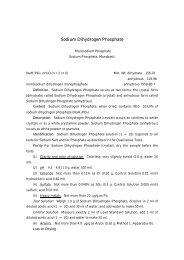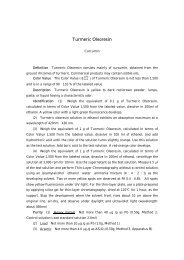Ferrous Gluconate
Ferrous Gluconate
Ferrous Gluconate
- No tags were found...
Create successful ePaper yourself
Turn your PDF publications into a flip-book with our unique Google optimized e-Paper software.
<strong>Ferrous</strong> <strong>Gluconate</strong>Iron <strong>Gluconate</strong>C12H22FeO14nH2O (n=2 or 0) Mol. Wt. dihydrate 482.18 anhydrous 446.15monoferrous bis [(2R,3S,4R,5R)-2,3,4,5,6-pentahydroxyhexanoate]anhydrous 299-29-6Content <strong>Ferrous</strong> <strong>Gluconate</strong>, when dried, contains not less than 95.0% of ferrousgluconate (C12H22FeO14).Description <strong>Ferrous</strong> <strong>Gluconate</strong> occurs as yellow-gray to green-yellow powder orgranules, having a slight, characteristic odor.Identification (1) Measure 5 ml of warm <strong>Ferrous</strong> <strong>Gluconate</strong> solution (1 10),and proceed as directed under Identification (2) for Glucono-Lactone.(2) <strong>Ferrous</strong> <strong>Gluconate</strong> solution (1 20) responds to all tests for <strong>Ferrous</strong> Salt asdescribed in the Qualitative Tests.Purity (1) Heavy metals Not more than 20µg/g as Pb.Test Solution Weigh 1.0 g of <strong>Ferrous</strong> <strong>Gluconate</strong>, transfer into a crucible, moistenwith 2 ml of sulfuric acid, heat gradually until it is almost incinerated, and cool. Add 1ml of sulfuric acid, and heat gradually until the fumes of sulfuric acid are almost nolonger evolved. Ignite at 450550 until the residue incinerates. After cooling,dissolve the residue with 5 ml of diluted hydrochloric acid (1 2), and transfer thesolution into a separating funnel. Wash the crucible twice with 5 ml of dilutedhydrochloric acid (1 2) each time, transfer the washings into the separating funnel.Add ether, shake, allow to stand, and discard the separated ether layer. Perform theseprocedures three times; twice with 40 ml of ether each time and once with 20 ml ofether. Dissolve 0.05 g of hydroxylamine hydrochloride in the water layer, heat on awater bath for 10 minutes, add 1 drop of phenolphthalein TS, and add aqueousammonia until a pink color develops. After cooling, add dropwise diluted hydrochloricacid (1 2) until the solution becomes almost colorless, and add 4 ml of diluted acetic
acid (1 20) and water to make 50 ml.Control Solution Measure 2.0 ml of Lead Standard Solution, and proceed in thesame manner as the sample.(2) Ferric salt Not more than 2.0% as Fe 3+ .Weigh 5 g of <strong>Ferrous</strong> <strong>Gluconate</strong>, dissolve in 100 ml of water and 10 ml ofhydrochloric acid, add 3 g of potassium iodide, shake, allow to stand in a dark place for5 minutes, and titrate with 0.1 mol/l sodium thiosulfate (indicator: starch TS). Thevolume is not more than 18 ml.(5) Arsenic Not more than 4.0µg/g as As2O3 (0.50 g, Method 3, Apparatus B).(4) Oxalate Weigh 1.0 g of <strong>Ferrous</strong> <strong>Gluconate</strong>, dissolve in 10 ml of water and 2ml of hydrochloric acid, transfer into a separating funnel, and perform extraction twicewith 50 ml and 20 ml of ether. Combine the extracts, add 10 ml of water, evaporate theether on a water bath, and add 1 drop of acetic acid and 1 ml of calcium acetatesolution (1 20). No turbidity appears within 5 minutes.(5) Sucrose or reducing sugar Weigh 0.5 g of <strong>Ferrous</strong> <strong>Gluconate</strong>, add 10 ml ofwater, dissolve by warming, add 1 ml of ammonia TS, pass hydrogen sulfide throughthe solution, allow to stand for 30 minutes, and filter. Wash the residue on the filterpaper twice with 5 ml of water each time, combine the filtrate and the washings,neutralize with hydrochloric acid, and add 2 ml of diluted hydrochloric acid (1 4).Concentrate the solution to about 10 ml, cool, add 5 ml of anhydrous sodium carbonatesolution (1 8) and 20 ml of water, filter, and add water to the filtrate to make 100ml. To 5 ml of this solution, add 2 ml of Fehling's TS, and boil for 1 minute. A yellow tored precipitate is not formed immediately.Loss on Drying Not more than 10.0% (105, 4 hours).Assay Weigh accurately about 1.5 g of <strong>Ferrous</strong> <strong>Gluconate</strong>, previously dried,dissolve in 75 ml of water and 15 ml of diluted sulfuric acid (1 20), and add 0.25 g ofzinc dust. Allow to stand for 20 minutes, filter through a Gooch crucible with thin layerpreviously prepared of zinc dust, wash the residue with 10 ml of diluted sulfuric acid (1 20) and then with 10 ml of water, combine the filtrate and the washings, add 2drops of o-phenanthroline TS, filter with suction if necessary, and titrate immediatelywith 0.1 mol/l ceric sulfate. Perform a blank test in the same manner, and make anynecessary correction.1 ml of 0.1 mol/l ceric sulfate = 44.61 mg of C12H22FeO14
















